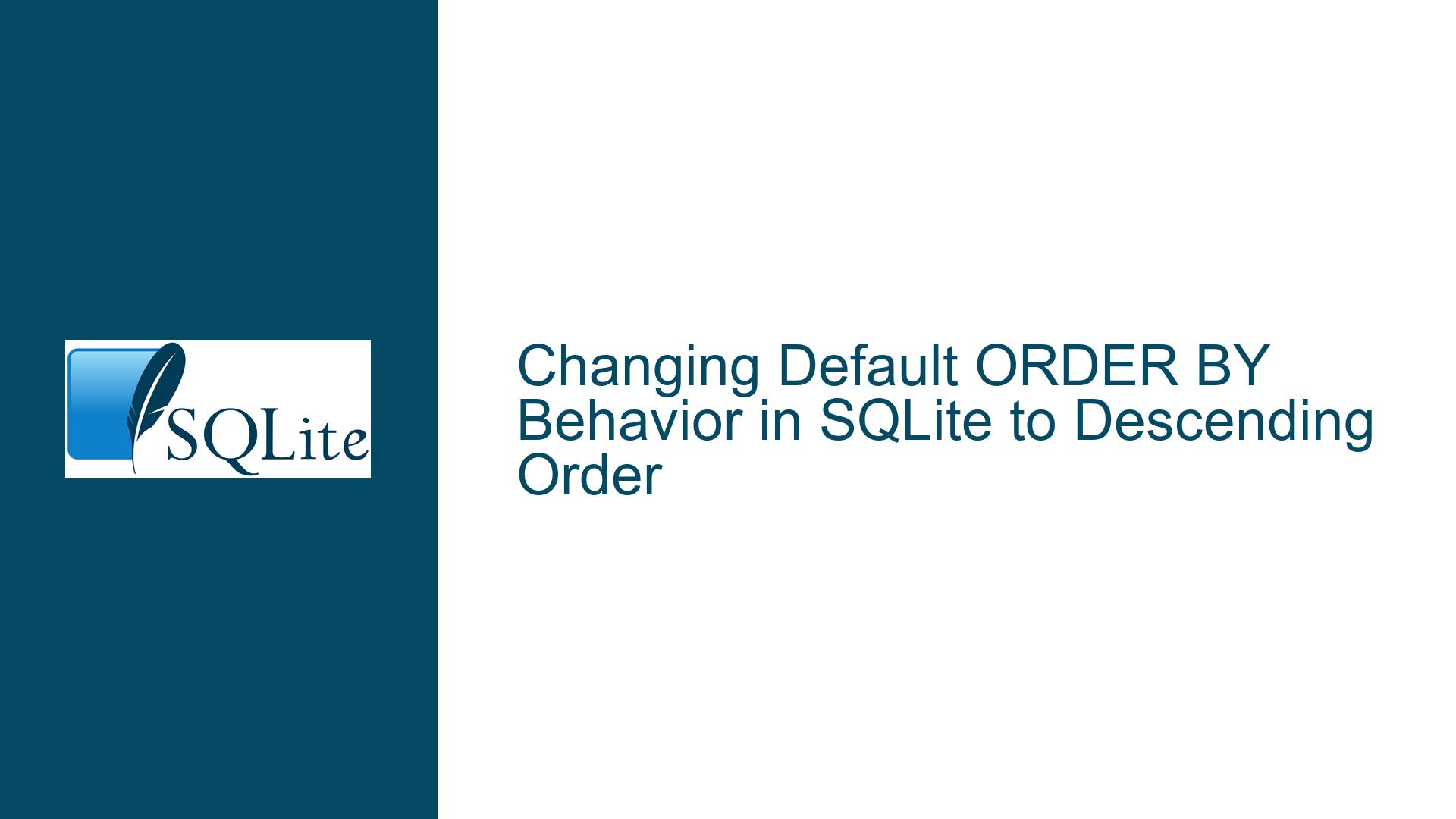Changing Default ORDER BY Behavior in SQLite to Descending Order
Understanding the Default ORDER BY Behavior in SQLite
SQLite, by default, orders query results in ascending order when the ORDER BY clause is used without specifying the direction. This behavior is deeply embedded in the SQLite query processing engine, specifically in the way the sqlite3VdbeExec function handles the sorting of result sets. The sorting mechanism relies on the comparison functions defined for the data types being sorted, and these functions are designed to return a negative value if the first argument is less than the second, zero if they are equal, and a positive value if the first argument is greater than the second. This is the standard behavior for ascending order.
The ORDER BY clause in SQLite is processed during the execution phase of a query, where the Virtual Database Engine (VDBE) generates bytecode to perform the necessary operations. The bytecode includes instructions to compare rows and sort them based on the specified columns. The default behavior is to sort in ascending order, and this is hardcoded into the VDBE’s logic. To change this default behavior, one would need to modify the source code of SQLite, which is not a trivial task and is generally not recommended due to the complexity and potential for introducing bugs.
Custom Collations as a Solution for Inverting Sort Order
One of the most effective ways to achieve a default descending order without modifying the SQLite source code is to use custom collations. A collation in SQLite is a set of rules that determines how strings are compared and sorted. By defining a custom collation, you can invert the comparison logic, effectively changing the sort order from ascending to descending.
To create a custom collation, you would use the sqlite3_create_collation function, which allows you to register a new collation with the database. The custom collation function would take two strings as input and return a negative value if the first string should be considered greater than the second, zero if they are equal, and a positive value if the first string should be considered less than the second. This inversion of the comparison logic will result in a descending sort order when the collation is used in an ORDER BY clause.
Here is an example of how you might define a custom collation in SQLite:
#include <sqlite3.h>
#include <string.h>
int inverted_collation(void* data, int len1, const void* str1, int len2, const void* str2) {
int result = strncmp((const char*)str1, (const char*)str2, (len1 < len2) ? len1 : len2);
return -result; // Invert the result to change the sort order
}
int main() {
sqlite3* db;
sqlite3_open(":memory:", &db);
sqlite3_create_collation(db, "INVERTED", SQLITE_UTF8, NULL, inverted_collation);
// Use the custom collation in a query
sqlite3_exec(db, "CREATE TABLE test (id INTEGER, name TEXT);", NULL, NULL, NULL);
sqlite3_exec(db, "INSERT INTO test (id, name) VALUES (1, 'Alice'), (2, 'Bob'), (3, 'Charlie');", NULL, NULL, NULL);
sqlite3_exec(db, "SELECT * FROM test ORDER BY name COLLATE INVERTED;", NULL, NULL, NULL);
sqlite3_close(db);
return 0;
}
In this example, the inverted_collation function is defined to invert the result of the standard strncmp function. This custom collation is then registered with the database using sqlite3_create_collation, and it can be used in an ORDER BY clause to achieve a descending sort order.
Implementing PRAGMA journal_mode and Database Backup for Robustness
While custom collations provide a way to change the default sort order, it is also important to consider the robustness of your SQLite database, especially when making changes to its behavior. One way to ensure that your database remains consistent and recoverable is to use the PRAGMA journal_mode statement to enable write-ahead logging (WAL) or another journaling mode that suits your needs. The journal mode determines how SQLite handles transactions and ensures data integrity in the event of a crash or power failure.
The PRAGMA journal_mode statement can be used to set the journaling mode to one of the following values: DELETE, TRUNCATE, PERSIST, MEMORY, WAL, or OFF. Each mode has its own trade-offs in terms of performance and durability. For example, the WAL mode allows for concurrent reads and writes, which can improve performance in multi-threaded applications, but it requires more careful management of the WAL file to avoid excessive growth.
Here is an example of how to set the journal mode to WAL:
PRAGMA journal_mode=WAL;
In addition to setting the journal mode, it is also important to implement a robust backup strategy for your SQLite database. SQLite provides several methods for backing up a database, including the sqlite3_backup_init API, which allows you to create an online backup of a database while it is in use. This API can be used to copy the contents of one database to another, either incrementally or in a single operation.
Here is an example of how to use the sqlite3_backup_init API to create a backup of a database:
#include <sqlite3.h>
#include <stdio.h>
int main() {
sqlite3* db;
sqlite3* backup_db;
sqlite3_backup* backup;
sqlite3_open("source.db", &db);
sqlite3_open("backup.db", &backup_db);
backup = sqlite3_backup_init(backup_db, "main", db, "main");
if (backup) {
sqlite3_backup_step(backup, -1); // Copy all pages
sqlite3_backup_finish(backup);
}
sqlite3_close(db);
sqlite3_close(backup_db);
return 0;
}
In this example, the sqlite3_backup_init function is used to initialize a backup operation from the source.db database to the backup.db database. The sqlite3_backup_step function is then called with a negative value to copy all pages from the source database to the backup database. Finally, the sqlite3_backup_finish function is called to complete the backup operation.
By combining custom collations with robust journaling and backup strategies, you can achieve the desired default descending sort order in SQLite while ensuring that your database remains consistent and recoverable in the face of unexpected events.






